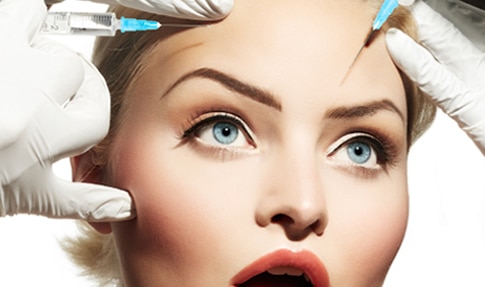Botulinum toxin (Botox) is a neurotoxin produced by the bacterium Clostridium botulinum. It is one of the most potent poisons known and as little as 1 gram of botulinum toxin could kill over 1 million people. Two kilograms could kill the entire human population of Earth.
However, targeted and controlled use of Botox has been proven to be therapeutic and has several medical uses as in the treatment of strabismus, excessive sweating, migraine and reduction of facial wrinkles. Keep reading to get answers to your question, is Botox safe, its common uses, side effects to look out for, and more.

Young woman getting botox.
Medical Uses of Botox
Botulinum toxin is used to treat several therapeutic indications. Some of the therapeutic use of Botox injection is as follows:
Strabismus is a condition in which the eyes do not properly align with each other when looking at an object. The eye which is focused on an object can alternate.
In 1989, the US FDA approved Botulinum toxin therapy for strabismus in people over 12 years old. The toxin is injected into the stronger muscle, causing temporary and partial paralysis. The treatment may need to be repeated three to four months later once the paralysis wears off. The botox injection in the treatment of strabismus is as successful as strabismus surgery.
Related: Blepharospasm
- Excessive sweating
Excessive sweating (hyperhidrosis) is also another use case for Botox injection. Khalaf Bushara and David Park were the first to show that Botox injections inhibit sweating and so can be used to treat patients with excessive sweating.
- Migraine
Migraine is a type of headache of varying intensity, often accompanied by nausea and sensitivity to light and sound. Botox injection has been approved as a method of treating and preventing chronic migraine headaches.
- Cosmetics
Botox is also used as a cosmetic to reduce facial wrinkles. Injection of botulinum toxin into the muscles under facial wrinkles causes relaxation of those muscles, resulting in the smoothing of the overlying skin. Smoothing of wrinkles is usually visible three-five days after injection, with maximum effect typically a week following injection. Muscles can be treated repeatedly to maintain a smoothed appearance.
Botox injection for cosmetic purposes is generally safe with little or no side effects.
The drug is under development for the treatment of depression and premature ejaculation.
Side Effects of Botox
While Botox injection is generally considered safe in a clinical setting, there can be serious side effects from its use. Some of the common side effects associated with Botox are as follows:
- Paralysis – The general effect of Botox injection is muscle relaxation hence, when Botox is applied to the wrong muscle group or spread from the injection site, paralysis of unintended muscles often results. In cosmetic application of Botox injection, there may be partial facial paralysis, muscle weakness, and trouble swallowing. These side effects often resolve after a few weeks after treatment. In the therapeutic use of Botox injection, side effects are often more serious. These can arise from paralysis of critical muscle groups and can include arrhythmia, heart attack, and in some cases seizures, respiratory arrest, and death.
- Headaches
- Flu-like symptoms
- Allergic reactions
- Shortness of breath
Remember that your doctor has prescribed this medication because he or she has judged that the benefit to you is greater than the risk of side effects. Many people using this medication do not have serious side effects.
A very serious allergic reaction to this drug is rare. However, get medical help right away if you notice any symptoms of a serious allergic reaction, including itching/swelling (especially of the face/tongue/throat), rash, severe dizziness, trouble breathing.
Is Botox Safe?
Although botulinum toxin is life-threatening, small doses — such as those used in the application of Botox — are considered safe.
Only 36 cases of Trusted Source of adverse effects associated with cosmetic use were reported to the U. S. Food and Drug Administration (FDA) between 1989 and 2003. Thirteen of these cases may have had more to do with an underlying condition than with the drug itself.
With that in mind, some researchers speculate that cosmetic applications may carry less risk than therapeutic Botox injections, as the doses are usually much smaller.
More: Types of Surgery


